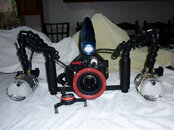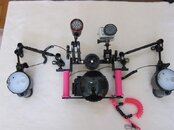DSR-3
Contributor
I never looked seriously at DSLR (I knew it was too big for me, and it looked like too many $$ to hide...), and I thought it was even a bit of an exaggeration when I wrote that. But, I spent less than that for everything you see here*. I did buy the camera, strobes, BigBlue, and Y-cable used, the SubSee was a gift, and the rest is DIY. *That would even include the Tamrac 9 backpack that it all fits in.You spent less than $1500 on a MFT with an UW housing? I guess you didnt buy any strobes or other "optional extras"..
No doubt there are some killer deals out there on used DSLR's & kit, and I'm not trying to debate any of this- just stating my example.





